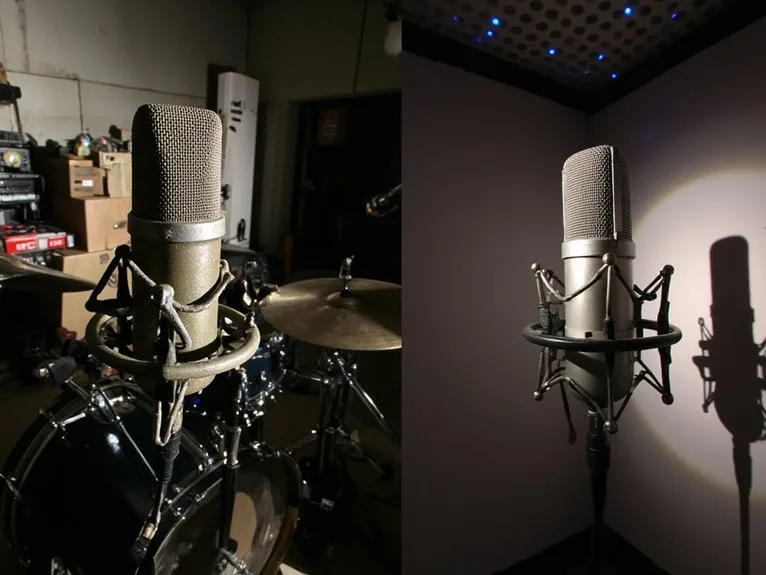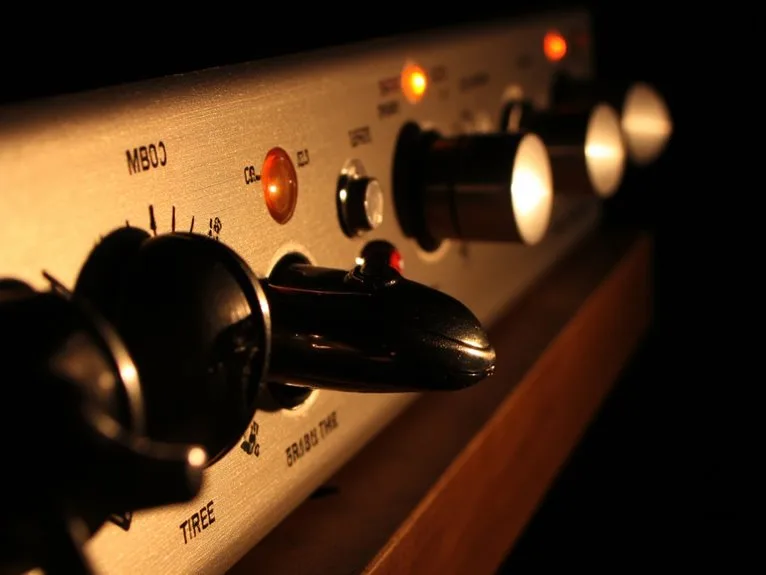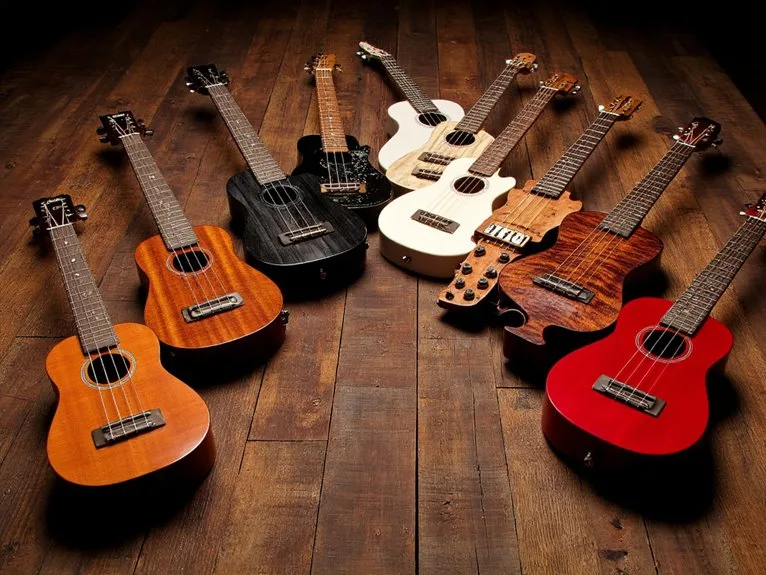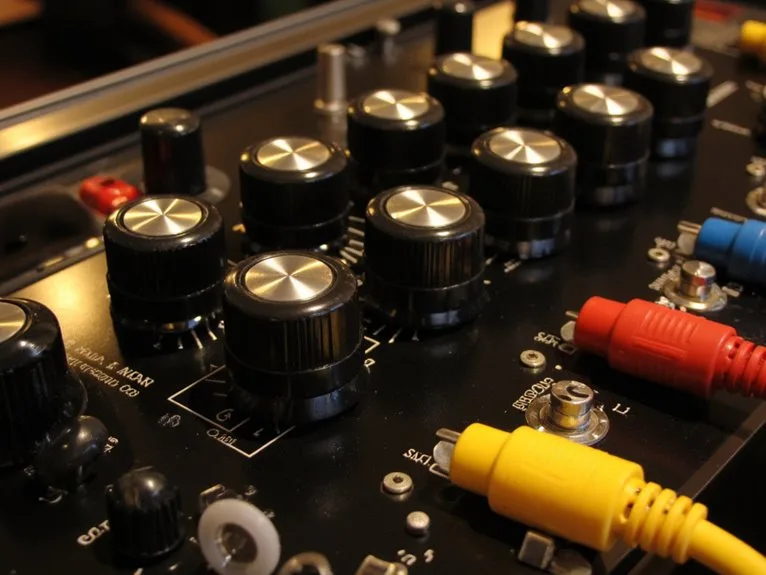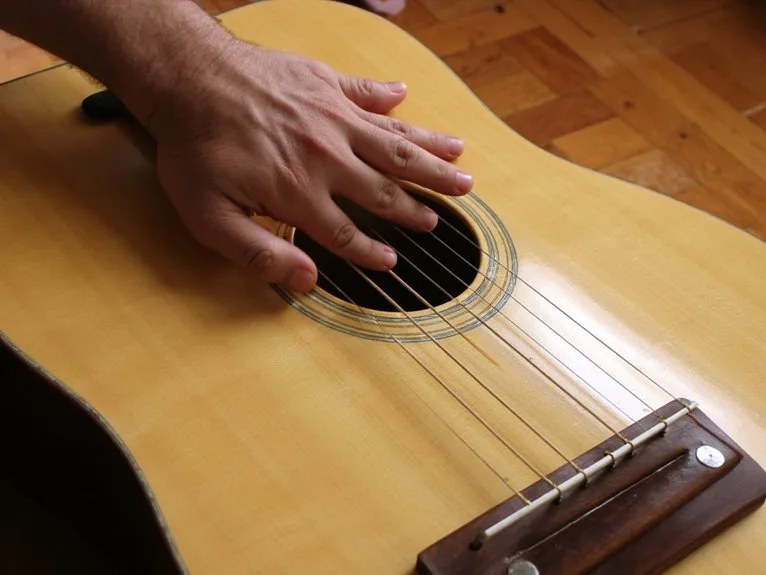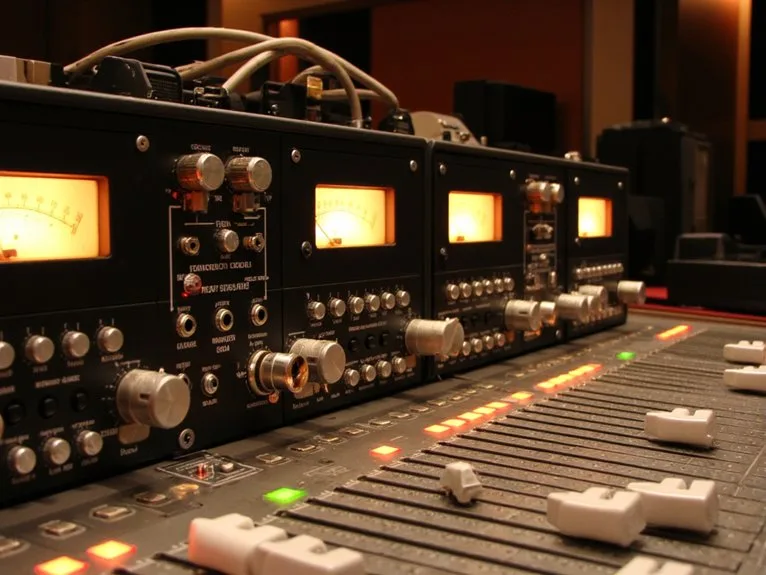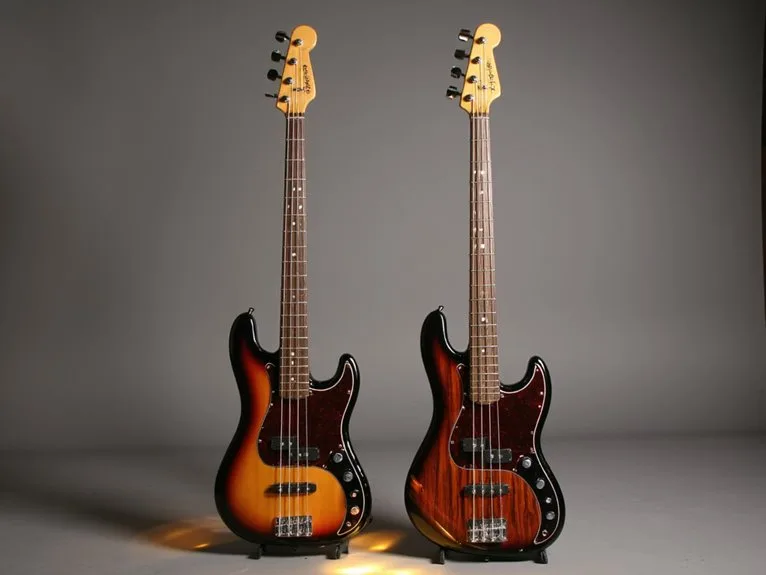When to Use Dynamic Microphones Vs Condensers
You’ll want dynamic microphones for live performances, drum recording, and noisy environments since they’re rugged, don’t need power, and handle high sound pressure levels up to 140dB without distortion. Choose condensers for studio vocals, acoustic instruments, and controlled settings where you need superior sensitivity and wider frequency response, though they require 48V phantom power and careful handling due to their delicate construction. The specifics of your recording situation will determine which technology serves you best.
We are supported by our audience. When you purchase through links on our site, we may earn an affiliate commission, at no extra cost for you. Learn more.
Notable Insights
- Use dynamic microphones for live performances, loud instruments like drums, and untreated rooms due to their durability and noise rejection.
- Choose condenser microphones for studio recording of vocals, acoustic instruments, and situations requiring detailed frequency response and sensitivity.
- Dynamic microphones require no external power and handle high sound pressure levels up to 140dB without distortion.
- Condenser microphones need 48V phantom power but capture wider frequency ranges and subtle audio nuances better than dynamics.
- Consider environmental factors: dynamics withstand moisture and temperature changes while condensers are fragile and humidity-sensitive.
Understanding the Core Technology Behind Each Microphone Type
The heart of every microphone lies in its transduction method—the fundamental process that transforms sound waves into electrical signals you can record, amplify, or broadcast.
When you’re choosing between microphone types, understanding these core technologies becomes essential for making informed decisions about sound dynamics in your recordings.
Dynamic microphones operate through electromagnetic induction, where a diaphragm-attached coil moves within a magnetic field, generating electrical current without external power.
Condenser microphones, however, use capacitor principles—their diaphragm acts as one plate of a capacitor, with sound waves creating capacitance variations that translate into voltage changes.
This fundamental difference explains why condensers require phantom power while dynamics don’t, and why each excels in specific recording environments based on their inherent technological strengths. Dynamic microphones excel at rejecting background noise, making them ideal for untreated rooms and noisy environments. Dynamic microphones generally operate well in various temperatures and do not require regular maintenance, making them particularly suitable for challenging environmental conditions. Dynamic microphones can handle high sound pressure levels up to 140dB before distortion, making them ideal for recording loud sources. Condenser microphones need +48V phantom power to boost voltage for proper sound output.
Sensitivity and Frequency Response Characteristics
When it comes to microphone performance, sensitivity and frequency response represent the two most crucial specifications that’ll determine whether your recordings capture every nuanced detail or fall flat in essential moments.
Understanding sensitivity differences between dynamic and condenser microphones reveals why condensers excel at picking up subtle audio details, while dynamics require higher preamp gain but handle loud sources without distortion.
Condenser mics capture subtle details with ease, while dynamic mics need more gain but excel with loud sources.
Condenser microphones offer broader frequency response ranges, accurately reproducing both highs and lows for natural sound capture, making them ideal for vocals and acoustic instruments. Dynamic microphones utilize electromagnetic induction with a diaphragm attached to a coil of wire, which contributes to their robust construction and ability to handle high sound pressure levels.
Dynamics feature narrower frequency response optimized for midrange and high SPL environments, focusing on durability over extended range. Condenser microphones require 48V phantom power to operate their diaphragm-based conversion system.
The high sensitivity of condenser microphones can capture unwanted ambient noise in untreated recording environments, making room acoustics a critical consideration for optimal results. Professional dynamic microphones like the Shure SM58 feature a cardioid pattern that effectively minimizes background noise during live performances.
These characteristics directly influence whether you’ll achieve studio-quality recordings or reliable live performance capture.
Power Requirements and Setup Considerations
One fundamental difference I’ve learned through years of recording experience involves how these microphones handle power requirements, and it’s a distinction that’ll directly impact your recording setup from day one.
Dynamic microphones operate without any external power source, generating electrical signals through electromagnetic induction, which means you can plug them directly into preamps or mixers and start recording immediately. Their durable construction makes them particularly reliable for demanding recording situations.
Condenser microphones, however, require phantom power—typically 48 volts DC supplied through XLR cables—for their built-in amplifiers and impedance conversion circuitry. Power consumption for condensers typically ranges from 50µW to 500mW, making them relatively efficient despite their power dependency. Many modern condensers offer USB plug-and-play connectivity that eliminates the need for separate audio interfaces while providing the necessary power through the USB connection. Consider connectivity options carefully when selecting between USB, TRS, and TRRS connections to ensure compatibility with your recording equipment and workflow requirements.
This microphone connectivity difference affects your equipment choices, as you’ll need audio interfaces with phantom power switches for condensers, while dynamics offer plug-and-play convenience that suits portable recording setups where power supply options might be limited.
Durability and Physical Resilience Factors
When you’re investing in microphones, you’ll quickly discover that the physical construction materials, impact resistance capabilities, and environmental performance limits create significant differences between dynamic and condenser models that directly affect their longevity and reliability.
I’ve seen countless musicians learn this lesson the hard way when their delicate condenser mic doesn’t survive a single tour, while their trusty dynamic microphone continues performing after years of abuse, drops, and temperature extremes that would destroy more sensitive equipment. Dynamic microphones are considered the sturdiest and most durable type of microphone, making them the clear winner for demanding performance environments.
Your choice between these microphone types should heavily consider where and how you’ll use them, since the trade-off between audio sensitivity and physical durability often determines whether your investment will last months or decades in real-world conditions. The typical lifespan ranges from 5-10 years depending on usage, with proper care and storage being crucial factors in maximizing longevity. Dynamic microphones with rugged metal construction and steel mesh grilles ensure superior durability against moisture and physical damage compared to their condenser counterparts. Regular maintenance checks are essential for both types, alongside proper storage to extend their lifespan.
Construction Materials Matter
Although both dynamic and condenser microphones might look similar from the outside, I’ve found that their construction materials tell completely different stories about durability and resilience.
Dynamic microphones leverage zinc alloy die-cast bodies, providing exceptional corrosion resistance and impact protection, while their semi-rigid diaphragms balance strength with responsiveness. The material quality in dynamics includes moisture-filtering grilles and pneumatic shockmount integration, markedly extending microphone longevity under demanding conditions.
Condenser mics, however, prioritize sensitivity over durability, featuring delicate conductive diaphragms and complex internal electronics that sacrifice robustness. You’ll notice condensers require controlled environments and careful handling, whereas dynamics incorporate protective materials designed for rough touring conditions, extreme temperatures, and moisture exposure without compromising performance or requiring frequent maintenance intervals. The superior magnetic field strength from neodymium magnets in modern dynamics further enhances their audio definition while contributing to lighter, more portable designs. This makes dynamics particularly suitable for live recordings where equipment faces unpredictable environmental challenges.
Impact Resistance Capabilities
While construction materials provide the foundation for microphone resilience, I’ve discovered that real-world impact resistance tells a more nuanced story about how these microphones actually survive the bumps, drops, and chaos of everyday use.
Dynamic microphones consistently demonstrate superior impact durability, withstanding drops, bumps, and rough handling that would leave condensers requiring repair. Their robust construction and fewer delicate internal components make them ideal for touring musicians, live venues, and unpredictable environments where accidents happen.
Condensers, despite their reputation for fragility, show surprising performance resilience in specific scenarios. Their lightweight membranes can actually survive certain drops better than heavier dynamic systems, though their sensitive capacitors and electronic components remain vulnerable to physical stress.
This makes them better suited for controlled studio environments where careful handling is standard practice.
Environmental Performance Limits
Beyond the immediate shock of drops and collisions, I’ve found that environmental factors create a constant, grinding test of microphone endurance that often proves more decisive than dramatic accidents.
Your condenser’s sensitive components face vulnerability from humidity fluctuations, temperature shifts, and dust infiltration that can degrade performance over months rather than minutes.
Environmental impact becomes particularly pronounced when you’re recording outdoors or in uncontrolled spaces where moisture and debris accumulate gradually.
Performance limitations emerge differently across microphone types:
- Dynamic mics tolerate moisture and temperature changes without significant degradation
- Condensers require phantom power, creating dependency issues in field conditions
- Humidity affects condenser diaphragms more severely than dynamic moving coils
- Dust penetration damages condenser electronics faster than dynamic internals
- Temperature fluctuations cause condensers to drift from calibrated specifications
Studio Recording Applications and Environments
When you’re setting up your studio recording sessions, I’ve found that your microphone choice dramatically impacts whether you’ll capture those delicate vocal nuances, pristine acoustic instrument details, or successfully manage the acoustic challenges of your particular recording space.
You’ll need to take into account how condensers excel at picking up the subtle breathing patterns and string resonances that make recordings feel alive, while dynamics offer you the reliability and noise rejection that untreated rooms often demand.
Your room’s acoustic treatment level, from professionally designed isolation booths to makeshift bedroom setups with moving blankets, fundamentally determines which microphone type will give you the cleanest, most professional results for your specific recording goals. Professional condensers often require phantom power to operate their internal preamps, which must be provided through your audio interface or mixer for optimal performance.
For optimal studio quality, ensure your microphone delivers a frequency response of 20Hz-20kHz and maintains a signal-to-noise ratio of 70 dB or higher to capture professional-grade recordings.
Vocal Recording Choices
As someone who’s spent countless hours behind the mixing board, I can tell you that choosing between dynamic and condenser microphones for studio vocal recording isn’t just about personal preference—it’s about matching the right tool to your specific recording environment, vocal style, and the level of detail you’re aiming to capture.
Your vocal delivery techniques and recording environments greatly influence this decision, with condensers excelling in acoustically treated spaces where you need pristine detail, while dynamics shine in less controlled settings.
- Condenser mics capture nuanced vocal articulation with wide frequency response, perfect for pop and ballad performances.
- Dynamic mics handle powerful vocal delivery without distortion, ideal for aggressive singing styles.
- Studio treatment determines mic choice—condensers need quiet, controlled spaces.
- Phantom power requirements make condensers more complex than plug-and-play dynamics.
- Durability factors favor dynamics for vocalists who move frequently during recording.
Live Performance and High-Volume Situations
When you’re stepping onto a stage where amplifiers are cranked to eleven and drums are pounding with relentless intensity, the microphone in your hand becomes far more than just a tool—it’s your lifeline to the audience, and choosing between dynamic and condenser models can make or break your performance.
Dynamic microphone advantages shine brightest in these chaos-filled environments, where their rugged construction withstands physical abuse while handling extreme sound pressure levels without distortion. Their plug-and-play nature eliminates phantom power dependencies that could leave you voiceless mid-song.
Meanwhile, condenser microphone disadvantages become painfully apparent as their delicate internals struggle with aggressive handling, their heightened sensitivity picks up unwanted stage noise, and their feedback-prone characteristics turn your monitor speakers into shrieking banshees that’ll clear the venue faster than a fire alarm.
Instrument-Specific Microphone Selection Guidelines
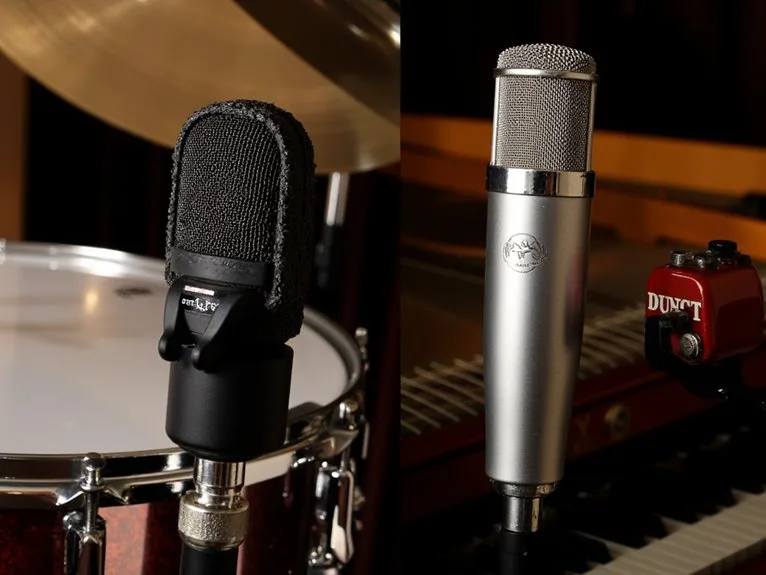
While vocals demand careful microphone consideration, selecting the right mic for specific instruments requires an even more nuanced understanding of acoustic properties, frequency ranges, and the unique sonic characteristics each instrument brings to your recording.
Different microphone types excel with specific instruments based on selection criteria like sound pressure levels, frequency response, and transient handling. I’ve found that matching the right mic to each instrument dramatically improves your recording quality, though it sometimes feels like solving a complex puzzle.
Here’s what works best for common instruments:
- Drums: Dynamic mics handle high SPLs without distortion, especially on snare and kick drums
- Wind instruments: Condenser mics capture breath nuances and complex frequency content
- Acoustic guitars/pianos: Large diaphragm condensers reveal harmonic richness and warmth
- Electric guitars: Dynamics provide punchy midrange focus for amplifier tones
- String instruments: Condensers track fast transients and subtle overtones precisely
On a final note
You’ll find that choosing between dynamic and condenser microphones isn’t rocket science, though I’ve certainly overthought it plenty of times myself. Dynamic mics excel in loud, unpredictable environments where durability matters, while condensers shine in controlled studio settings where capturing nuanced detail is paramount. Consider your recording environment, power availability, and sound source characteristics, then trust your ears—they’re usually right about what works best.

